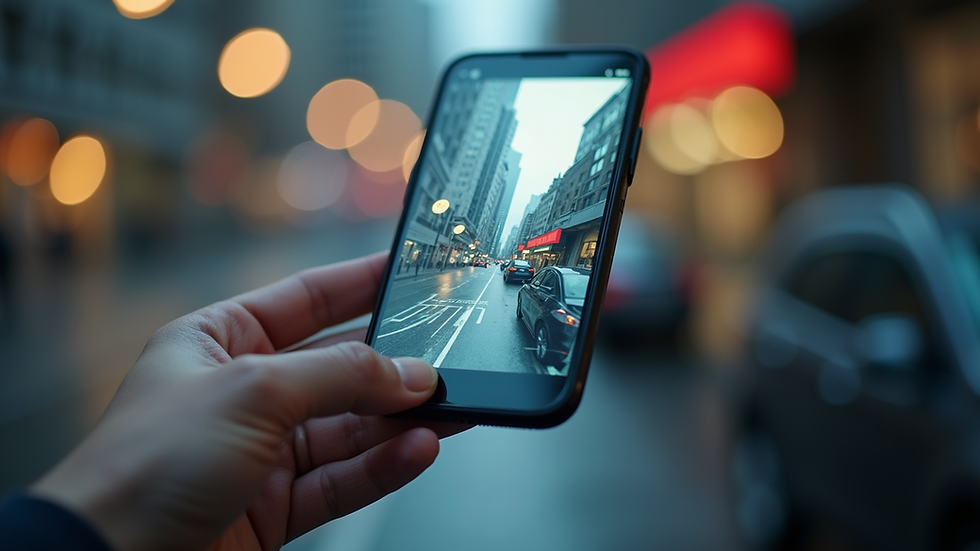Exploring the Role of Computer Vision in Navigation
- Shadnam Khan

- Jun 18, 2025
- 4 min read
Navigating through unfamiliar territories has always been a challenge for humans. But today, technology has a powerful ally: computer vision. By processing and interpreting visual data, computer vision plays a crucial role in making navigation systems smarter and more efficient. This blog will explore how computer vision is transforming navigation, enabling a new era of automation, safety, and convenience.
What is Computer Vision?
At its core, computer vision is a field of artificial intelligence that enables machines to interpret and understand visual information from the world around them. It involves processing images and videos to extract meaningful information. This technology allows computers to “see” and understand the visual context in which they function, mimicking human vision.
The application of computer vision in navigation primarily focuses on enabling devices to recognize their environment and make real-time decisions. From autonomous vehicles to augmented reality applications, computer vision forms the backbone of advanced navigation technologies.

Enhancing Navigation Systems with Computer Vision
Object Recognition in Autonomous Vehicles
One of the most significant applications of computer vision is in autonomous vehicles. These vehicles rely on advanced sensors and cameras to navigate safely. Object recognition plays a crucial role here by identifying various elements in the environment, such as pedestrians, road signs, and other vehicles.
For instance, a study by the National Highway Traffic Safety Administration (NHTSA) found that about 94% of crashes are attributable to human error. By integrating computer vision into navigation systems, autonomous vehicles can potentially reduce these errors, recognizing and reacting to threats faster than human drivers.

Real-time Navigation and Mapping
Computer vision also enables real-time navigation and mapping. Techniques such as visual odometry and simultaneous localization and mapping (SLAM) allow devices to create detailed maps of their surroundings by interpreting visual data in real time. This capability has immense implications for everything, from self-driving cars to drones.
For example, Google Maps employs computer vision in its Street View feature to create immersive experiences for users. Through sophisticated image processing techniques, it can create 3D models of streets and neighborhoods. This not only aids in navigation but also enhances user experience.
Augmented Reality Navigation
Augmented reality (AR) is another exciting area where computer vision excels. By overlaying digital information onto the real world, AR applications can improve navigation for everything from tourists exploring a city to technical professionals needing on-site guidance.
For instance, the application of computer vision through vps ar technology enables users to receive contextual navigation assistance. Users can see digital arrows pointing towards their destination overlaid on real-world images, reducing confusion and improving overall navigation.

Challenges in Implementing Computer Vision for Navigation
Despite its advantages, there are several challenges to effectively using computer vision in navigation systems.
Environmental Factors
Computer vision systems can struggle under certain environmental conditions. Low light, rain, or snow can obscure visual data and impact accuracy. For example, visibility issues can hinder object recognition, leading to potential navigation errors.
Data Privacy Concerns
The use of cameras and advanced imaging technology raises ethical and privacy concerns. Many users express discomfort with constant monitoring, which can lead to pushback against widespread implementation.
Integration with Existing Systems
Integrating computer vision capabilities into existing navigation systems can pose technical challenges. These systems require robust infrastructure and high-quality data to function optimally.
Despite these challenges, ongoing research and advancements in computer vision technology continue to address these issues, making navigation systems safer and more reliable.
Future Prospects of Computer Vision in Navigation
Improved Safety and Efficiency
As computer vision technology evolves, we can expect significant improvements in safety and efficiency. Enhanced object detection algorithms will allow navigation systems to operate with increased precision, ensuring that vehicles can respond to hazards more effectively.
Broader Applications
The potential applications of computer vision are broadening. Beyond autonomous vehicles, industries such as delivery, logistics, and public transportation are exploring how this technology can streamline their operations. For instance, drones leveraging computer vision could optimize delivery routes in real-time, reducing costs and improving efficiency.
Accessibility in Navigation Technology
Computer vision can also enhance accessibility in navigation. Tools designed for visually impaired individuals can use computer vision to provide auditory instructions based on real-world observations, significantly improving their navigation experience.
In addition, integrating computer vision into mobile apps can empower users with personalized navigation experiences, customized to their needs and preferences.
Final Thoughts
The role of computer vision in navigation is only set to grow. With advancements paving the way for smarter, safer, and more efficient navigation solutions, we stand on the brink of a revolution in the way we approach travel and exploration. By harnessing the power of computer vision, we can enhance our navigation systems and improve overall user experiences.
Stay tuned for exciting developments in this space, as computer vision continues to redefine how we navigate the world around us!




Comments